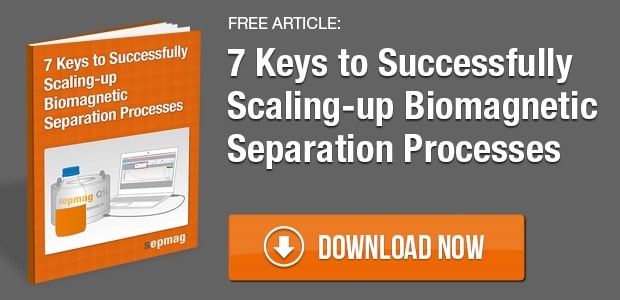When a magnetic field gradient is applied to a solution containing magnetic particles, aggregates of magnetic particles will separate out of the solution faster than individual magnetic beads. The increased speed is due to an increased magnetic moment as the beads gather and influence the magnetization of those nearby, and also due to a decreased drag force if the beads form chains. Therefore, it could be beneficial to attach a polymer to the surface of the magnetic beads that would help with aggregation.
Recent work demonstrates that magnetic beads with a temperature-responsive Poly(N-isopropylacrylamide) or PNIPAM shellhave a lower separation time in a magnetic field gradient than beads with a shell of unmodified Polyvinyl alcohol (PVA). PNIPAM changes from hydrophilic to hydrophobic as ambient temperature increases beyond 32°C. Therefore, PNIPAM is soluble in water at temperatures below 32°C as it forms hydrogen bonds with nearby water molecules. As the temperature increases beyond 32°C it becomes hydrophobic. The PNIPAM magnetic beads aggregate to seek a lower energy state by binding together. The maximum aggregation of PNIPAM magnetic beads was found to be at 40°C in 0.1 M phosphate buffer at pH 3-4. The aggregation was shown to be reversible.
In this study the group also investigated how the attachment of ionic copolymers, which allow protein binding, affects aggregation. When the PNIPAM beads are bound with the ionic copolymers alone they are unable to aggregate, but when protein is adsorbed to the copolymers, the ionic sites are covered and the beads are again able to aggregate. This allows for capture of proteins and magnetic separation of aggregates all in one system.
Temperature-switchable Agglomeration of Magnetic Particles Designed for Continuous Separation Processes in Biotechnology. Paulus AS, Heinzler R, Ooi HW, Franzreb M. ACS Appl Mater Interfaces.2015 Jun 12.
Related news:





